HRM Report: Roles, Functions, and Rules in Modern Organizations
VerifiedAdded on 2020/04/21
|27
|3485
|89
Report
AI Summary
This report provides a comprehensive overview of Human Resource Management (HRM), focusing on its crucial roles, functions, and the rules governing its practices within organizations. The report delves into key aspects such as recruitment and selection processes, emphasizing their significance in matching individuals with job specifications. It further explores the intricacies of pay, rewards, performance management, equity, diversity, and employee wellness, highlighting the importance of these elements in fostering a productive and satisfied workforce. The report examines various problems within HRM, including industrial relations issues, challenges in transforming personnel management, and the importance of aligning HR practices with business strategies. It discusses potential solutions for these problems, emphasizing the need for effective communication, flexible working environments, and strategic approaches to HRM. Furthermore, it covers the roles and responsibilities of HR managers, the significance of job analysis, psychological contracts, and the implementation of effective performance management systems. The report also addresses topics like strategic remuneration, employee safety, and health issues, providing a holistic view of HRM in the modern workplace. It concludes with recommendations aimed at improving HRM practices and enhancing organizational effectiveness.
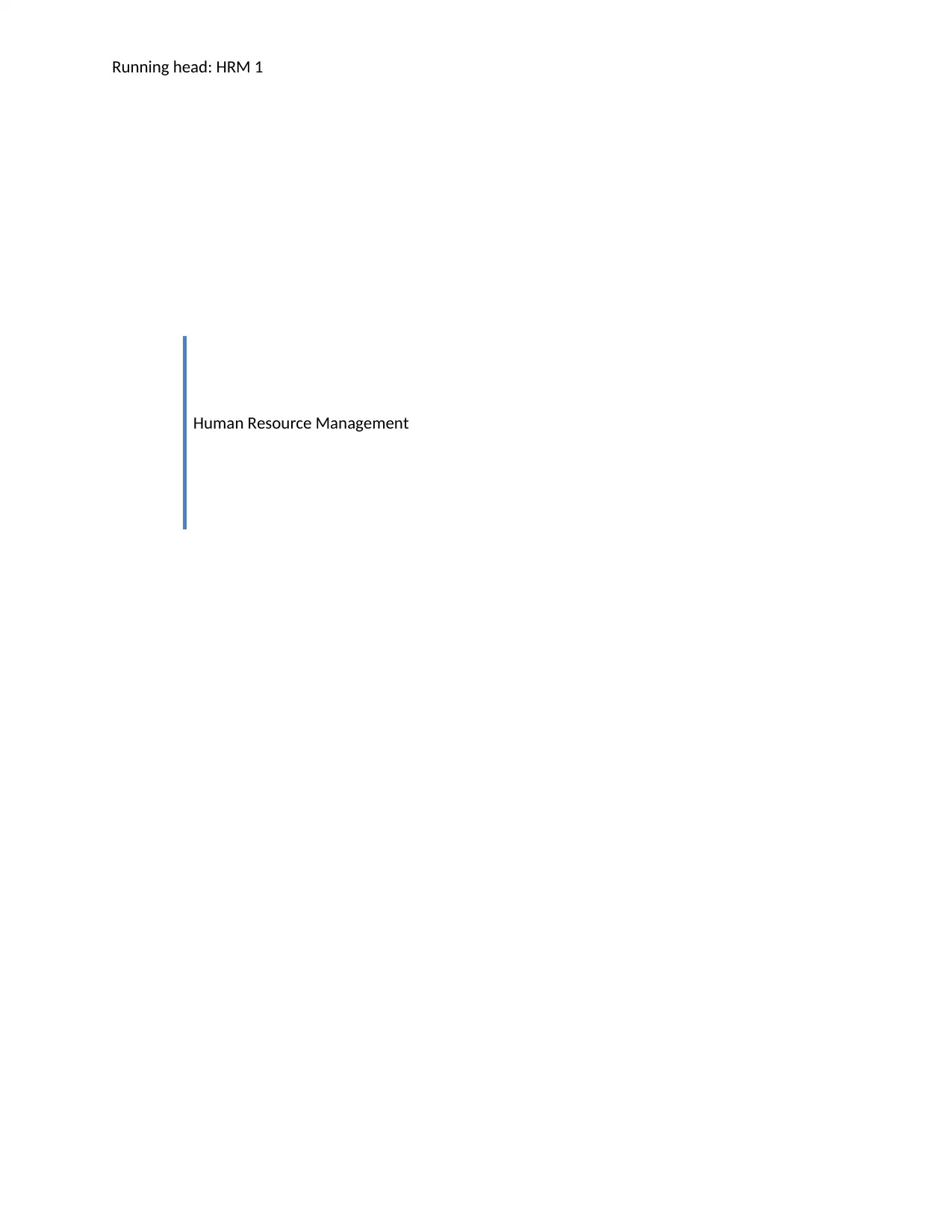
Running head: HRM 1
Human Resource Management
Human Resource Management
Paraphrase This Document
Need a fresh take? Get an instant paraphrase of this document with our AI Paraphraser
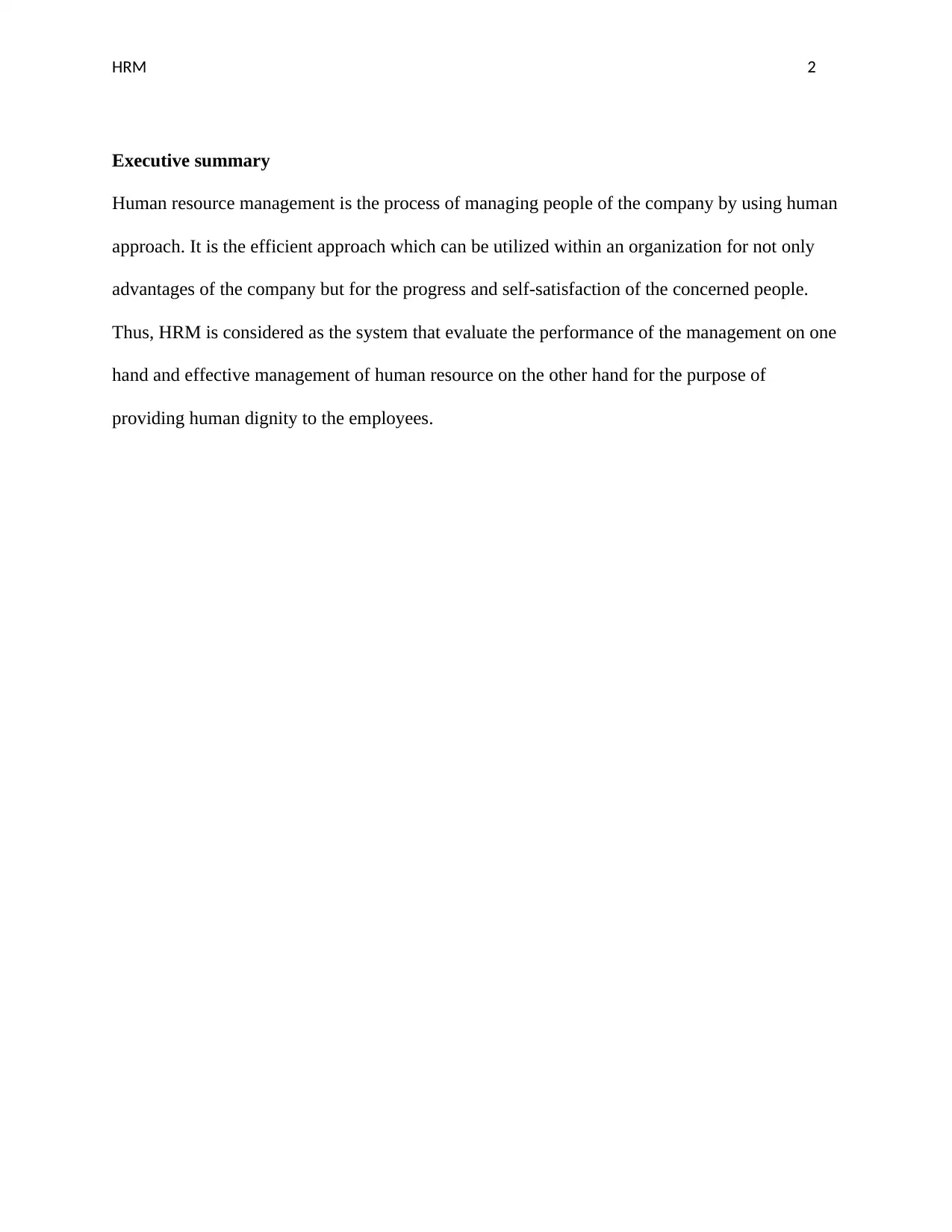
HRM 2
Executive summary
Human resource management is the process of managing people of the company by using human
approach. It is the efficient approach which can be utilized within an organization for not only
advantages of the company but for the progress and self-satisfaction of the concerned people.
Thus, HRM is considered as the system that evaluate the performance of the management on one
hand and effective management of human resource on the other hand for the purpose of
providing human dignity to the employees.
Executive summary
Human resource management is the process of managing people of the company by using human
approach. It is the efficient approach which can be utilized within an organization for not only
advantages of the company but for the progress and self-satisfaction of the concerned people.
Thus, HRM is considered as the system that evaluate the performance of the management on one
hand and effective management of human resource on the other hand for the purpose of
providing human dignity to the employees.
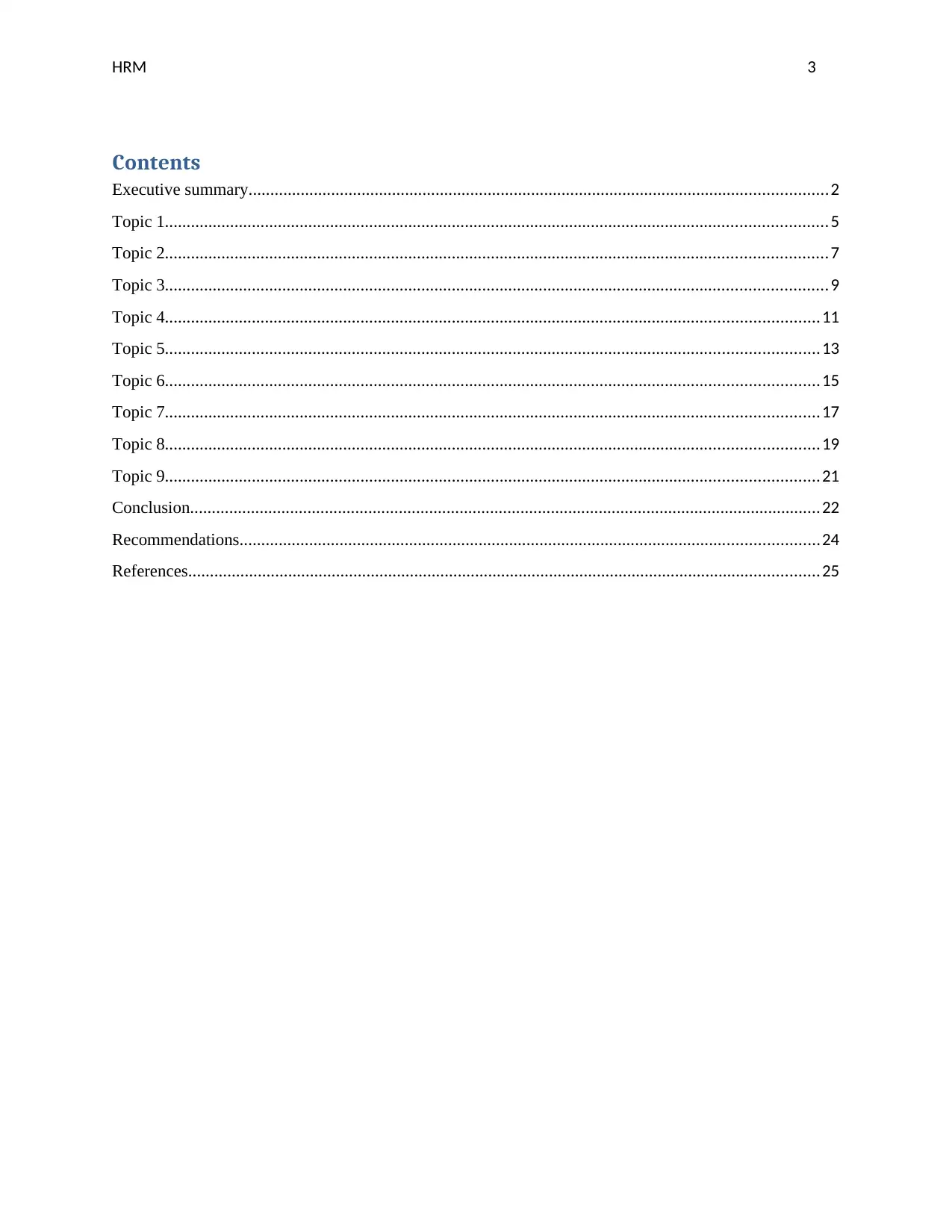
HRM 3
Contents
Executive summary.....................................................................................................................................2
Topic 1........................................................................................................................................................5
Topic 2........................................................................................................................................................7
Topic 3........................................................................................................................................................9
Topic 4......................................................................................................................................................11
Topic 5......................................................................................................................................................13
Topic 6......................................................................................................................................................15
Topic 7......................................................................................................................................................17
Topic 8......................................................................................................................................................19
Topic 9......................................................................................................................................................21
Conclusion.................................................................................................................................................22
Recommendations.....................................................................................................................................24
References.................................................................................................................................................25
Contents
Executive summary.....................................................................................................................................2
Topic 1........................................................................................................................................................5
Topic 2........................................................................................................................................................7
Topic 3........................................................................................................................................................9
Topic 4......................................................................................................................................................11
Topic 5......................................................................................................................................................13
Topic 6......................................................................................................................................................15
Topic 7......................................................................................................................................................17
Topic 8......................................................................................................................................................19
Topic 9......................................................................................................................................................21
Conclusion.................................................................................................................................................22
Recommendations.....................................................................................................................................24
References.................................................................................................................................................25
⊘ This is a preview!⊘
Do you want full access?
Subscribe today to unlock all pages.

Trusted by 1+ million students worldwide
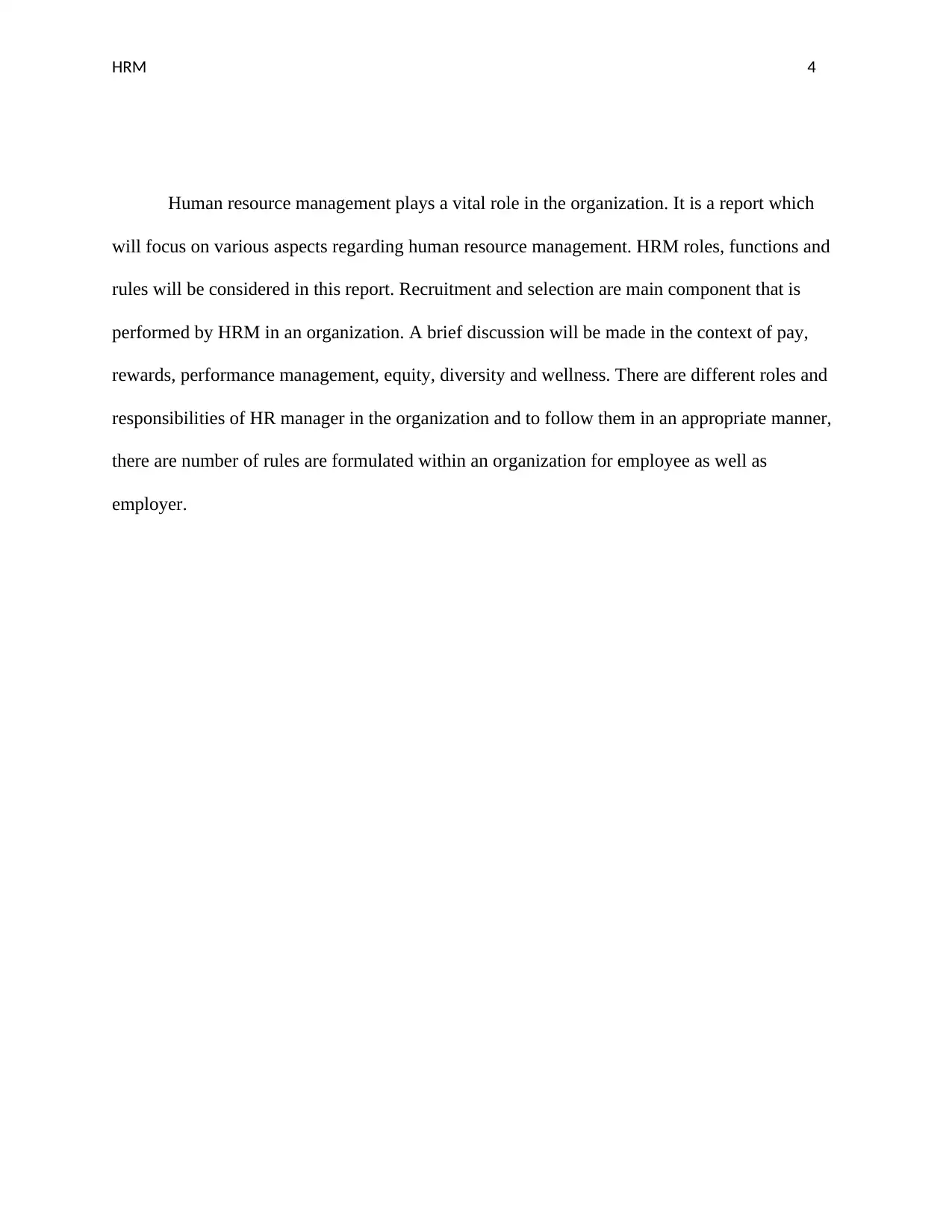
HRM 4
Human resource management plays a vital role in the organization. It is a report which
will focus on various aspects regarding human resource management. HRM roles, functions and
rules will be considered in this report. Recruitment and selection are main component that is
performed by HRM in an organization. A brief discussion will be made in the context of pay,
rewards, performance management, equity, diversity and wellness. There are different roles and
responsibilities of HR manager in the organization and to follow them in an appropriate manner,
there are number of rules are formulated within an organization for employee as well as
employer.
Human resource management plays a vital role in the organization. It is a report which
will focus on various aspects regarding human resource management. HRM roles, functions and
rules will be considered in this report. Recruitment and selection are main component that is
performed by HRM in an organization. A brief discussion will be made in the context of pay,
rewards, performance management, equity, diversity and wellness. There are different roles and
responsibilities of HR manager in the organization and to follow them in an appropriate manner,
there are number of rules are formulated within an organization for employee as well as
employer.
Paraphrase This Document
Need a fresh take? Get an instant paraphrase of this document with our AI Paraphraser
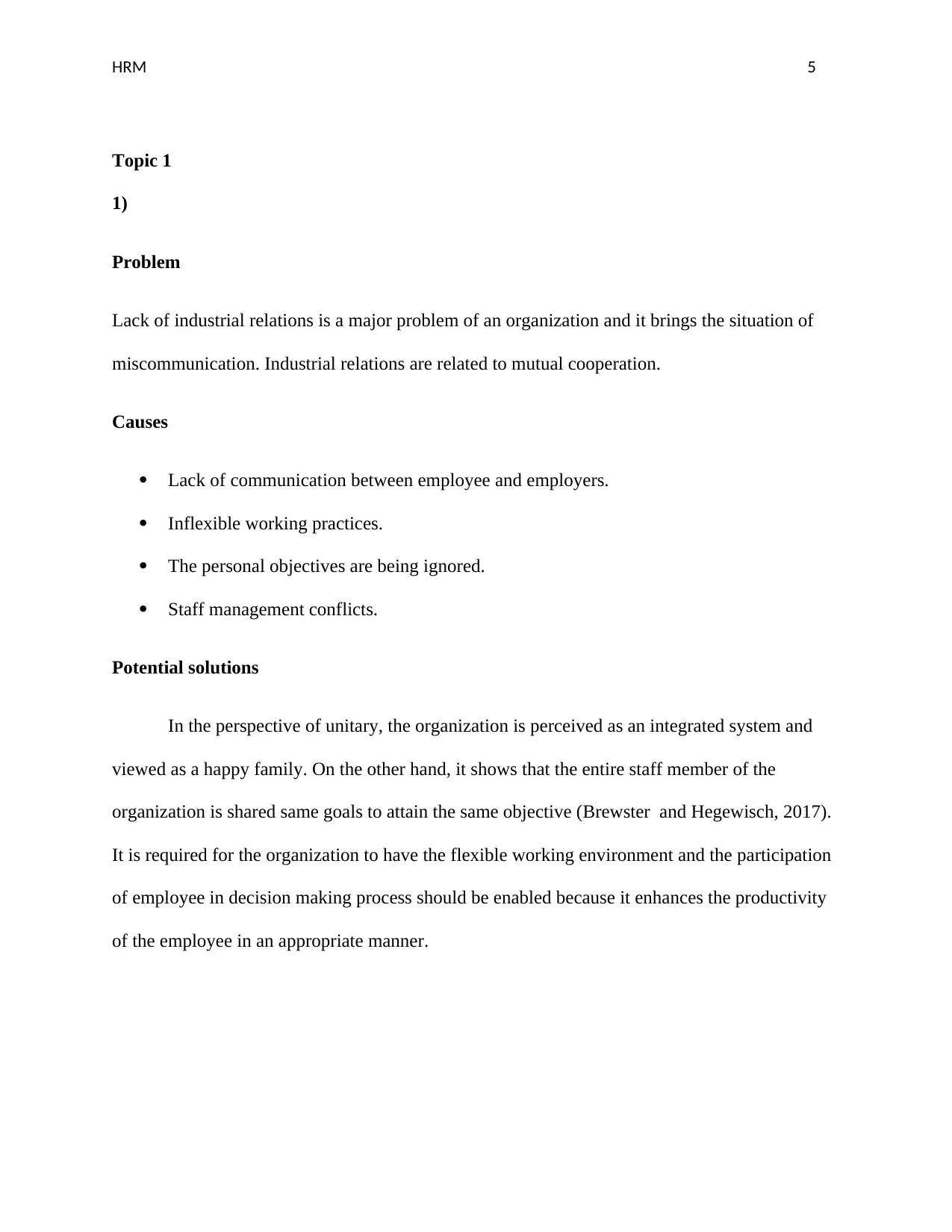
HRM 5
Topic 1
1)
Problem
Lack of industrial relations is a major problem of an organization and it brings the situation of
miscommunication. Industrial relations are related to mutual cooperation.
Causes
Lack of communication between employee and employers.
Inflexible working practices.
The personal objectives are being ignored.
Staff management conflicts.
Potential solutions
In the perspective of unitary, the organization is perceived as an integrated system and
viewed as a happy family. On the other hand, it shows that the entire staff member of the
organization is shared same goals to attain the same objective (Brewster and Hegewisch, 2017).
It is required for the organization to have the flexible working environment and the participation
of employee in decision making process should be enabled because it enhances the productivity
of the employee in an appropriate manner.
Topic 1
1)
Problem
Lack of industrial relations is a major problem of an organization and it brings the situation of
miscommunication. Industrial relations are related to mutual cooperation.
Causes
Lack of communication between employee and employers.
Inflexible working practices.
The personal objectives are being ignored.
Staff management conflicts.
Potential solutions
In the perspective of unitary, the organization is perceived as an integrated system and
viewed as a happy family. On the other hand, it shows that the entire staff member of the
organization is shared same goals to attain the same objective (Brewster and Hegewisch, 2017).
It is required for the organization to have the flexible working environment and the participation
of employee in decision making process should be enabled because it enhances the productivity
of the employee in an appropriate manner.
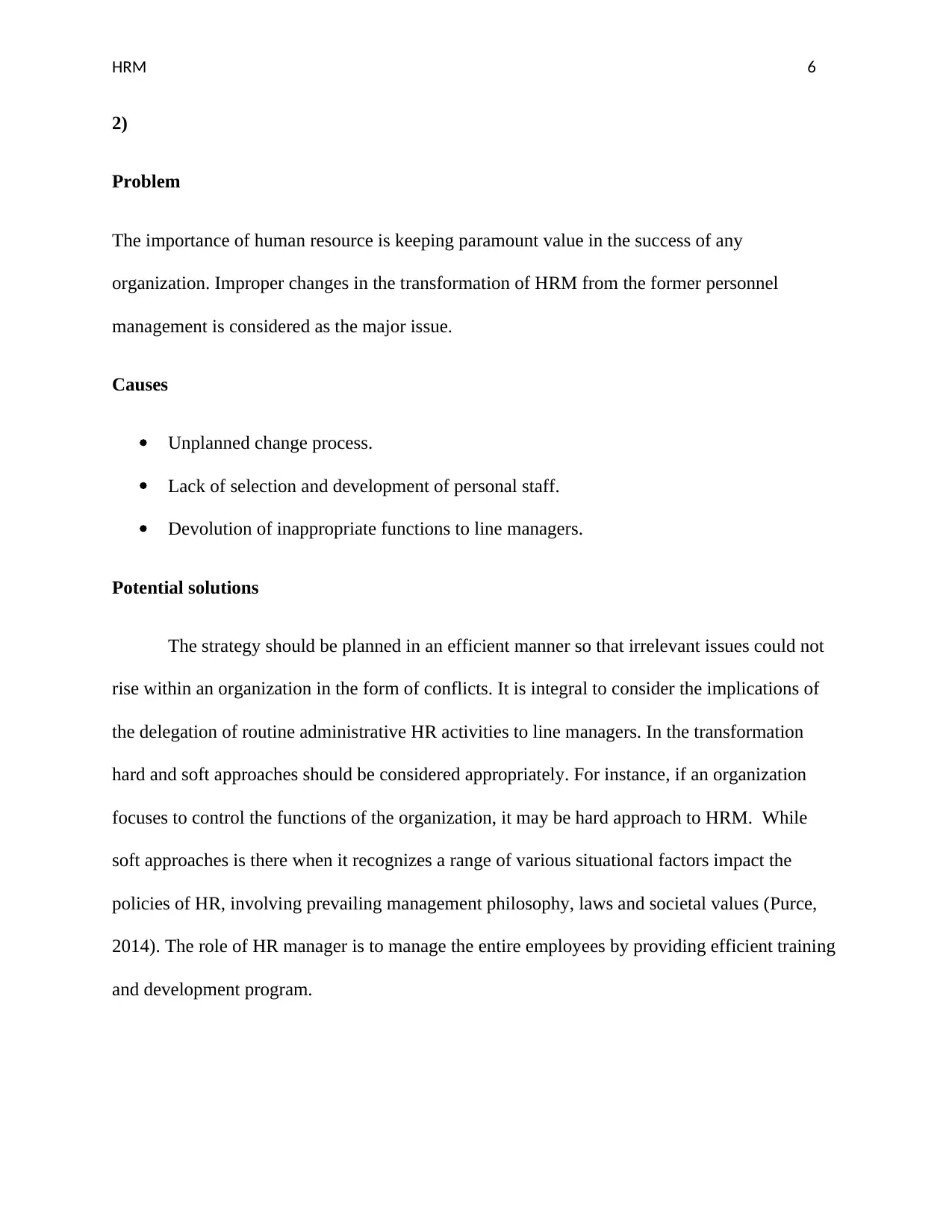
HRM 6
2)
Problem
The importance of human resource is keeping paramount value in the success of any
organization. Improper changes in the transformation of HRM from the former personnel
management is considered as the major issue.
Causes
Unplanned change process.
Lack of selection and development of personal staff.
Devolution of inappropriate functions to line managers.
Potential solutions
The strategy should be planned in an efficient manner so that irrelevant issues could not
rise within an organization in the form of conflicts. It is integral to consider the implications of
the delegation of routine administrative HR activities to line managers. In the transformation
hard and soft approaches should be considered appropriately. For instance, if an organization
focuses to control the functions of the organization, it may be hard approach to HRM. While
soft approaches is there when it recognizes a range of various situational factors impact the
policies of HR, involving prevailing management philosophy, laws and societal values (Purce,
2014). The role of HR manager is to manage the entire employees by providing efficient training
and development program.
2)
Problem
The importance of human resource is keeping paramount value in the success of any
organization. Improper changes in the transformation of HRM from the former personnel
management is considered as the major issue.
Causes
Unplanned change process.
Lack of selection and development of personal staff.
Devolution of inappropriate functions to line managers.
Potential solutions
The strategy should be planned in an efficient manner so that irrelevant issues could not
rise within an organization in the form of conflicts. It is integral to consider the implications of
the delegation of routine administrative HR activities to line managers. In the transformation
hard and soft approaches should be considered appropriately. For instance, if an organization
focuses to control the functions of the organization, it may be hard approach to HRM. While
soft approaches is there when it recognizes a range of various situational factors impact the
policies of HR, involving prevailing management philosophy, laws and societal values (Purce,
2014). The role of HR manager is to manage the entire employees by providing efficient training
and development program.
⊘ This is a preview!⊘
Do you want full access?
Subscribe today to unlock all pages.

Trusted by 1+ million students worldwide
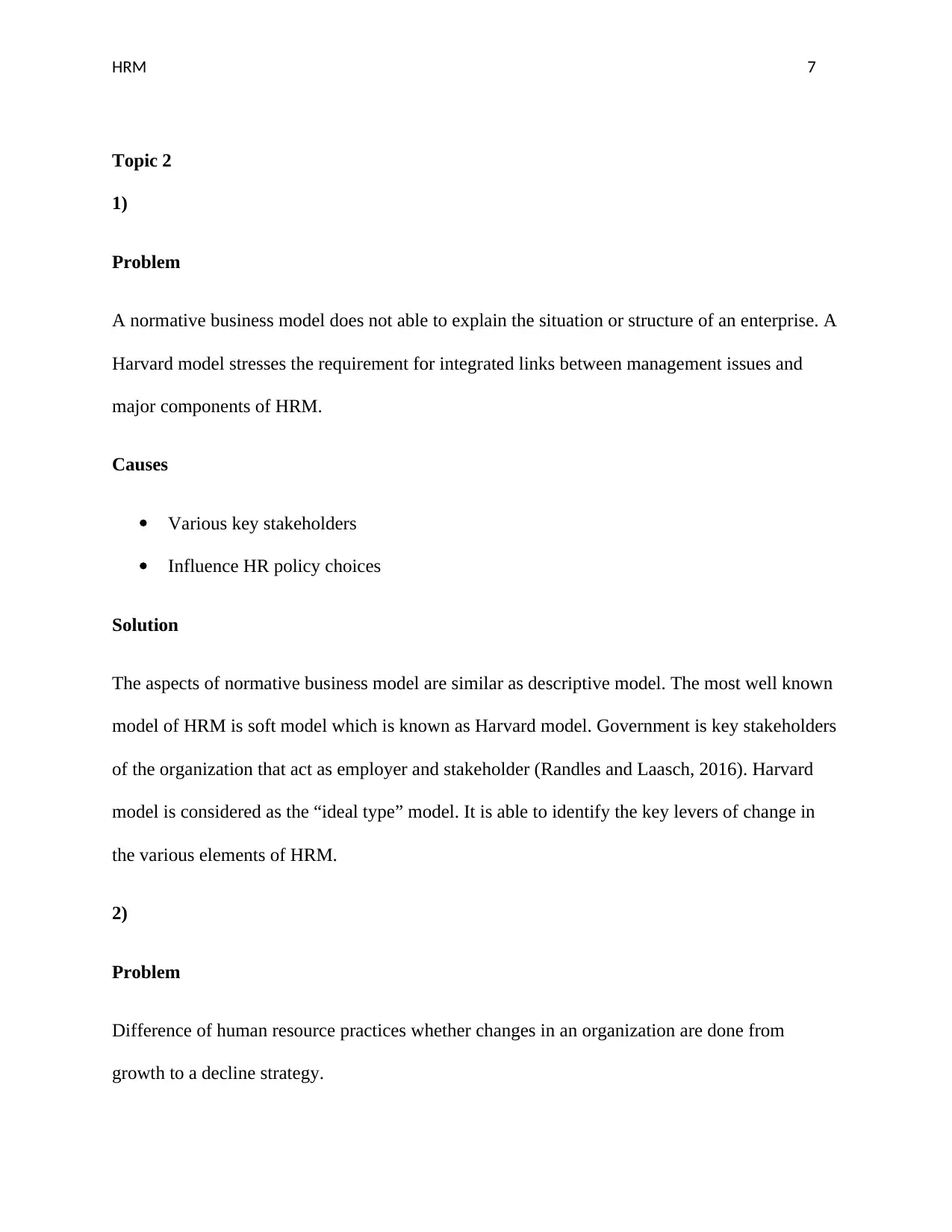
HRM 7
Topic 2
1)
Problem
A normative business model does not able to explain the situation or structure of an enterprise. A
Harvard model stresses the requirement for integrated links between management issues and
major components of HRM.
Causes
Various key stakeholders
Influence HR policy choices
Solution
The aspects of normative business model are similar as descriptive model. The most well known
model of HRM is soft model which is known as Harvard model. Government is key stakeholders
of the organization that act as employer and stakeholder (Randles and Laasch, 2016). Harvard
model is considered as the “ideal type” model. It is able to identify the key levers of change in
the various elements of HRM.
2)
Problem
Difference of human resource practices whether changes in an organization are done from
growth to a decline strategy.
Topic 2
1)
Problem
A normative business model does not able to explain the situation or structure of an enterprise. A
Harvard model stresses the requirement for integrated links between management issues and
major components of HRM.
Causes
Various key stakeholders
Influence HR policy choices
Solution
The aspects of normative business model are similar as descriptive model. The most well known
model of HRM is soft model which is known as Harvard model. Government is key stakeholders
of the organization that act as employer and stakeholder (Randles and Laasch, 2016). Harvard
model is considered as the “ideal type” model. It is able to identify the key levers of change in
the various elements of HRM.
2)
Problem
Difference of human resource practices whether changes in an organization are done from
growth to a decline strategy.
Paraphrase This Document
Need a fresh take? Get an instant paraphrase of this document with our AI Paraphraser
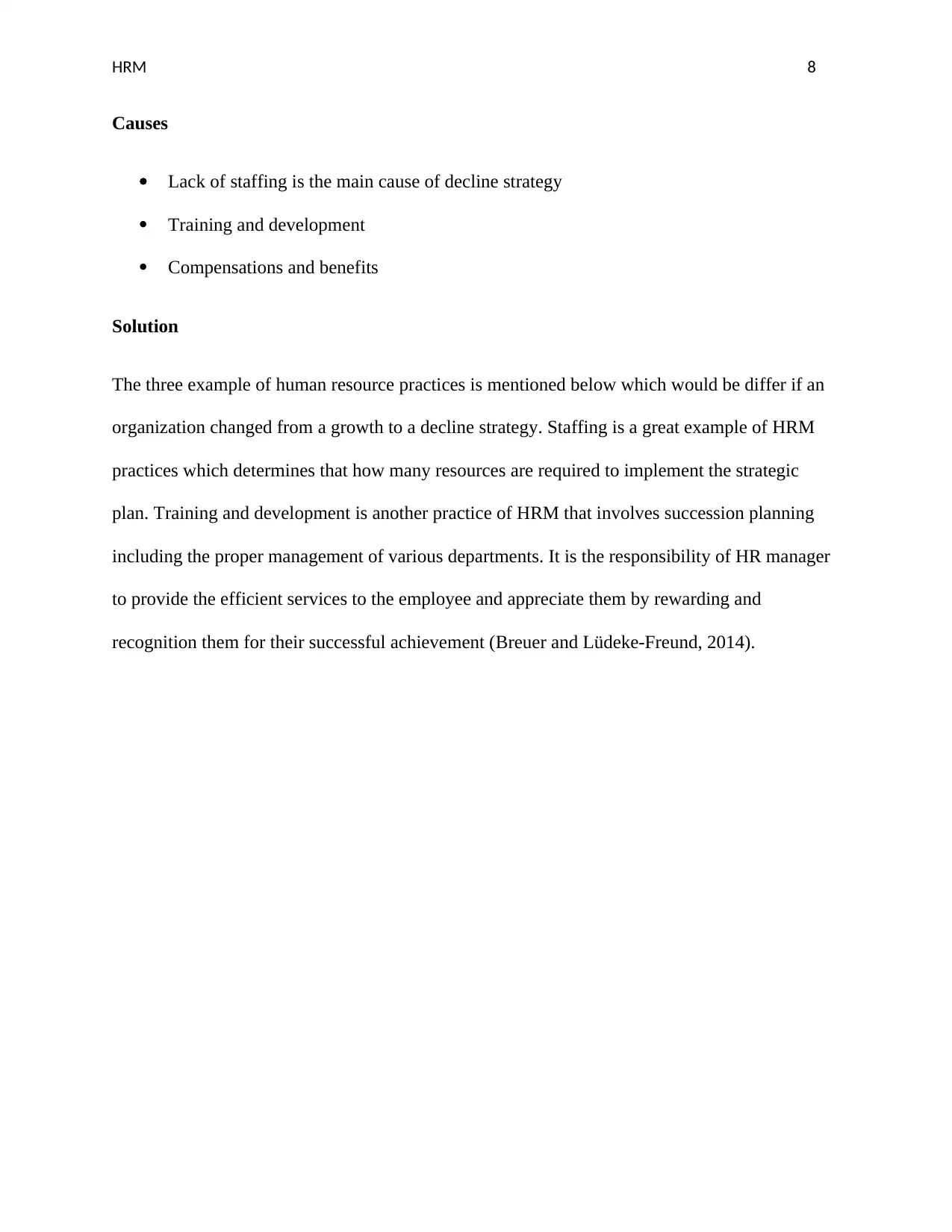
HRM 8
Causes
Lack of staffing is the main cause of decline strategy
Training and development
Compensations and benefits
Solution
The three example of human resource practices is mentioned below which would be differ if an
organization changed from a growth to a decline strategy. Staffing is a great example of HRM
practices which determines that how many resources are required to implement the strategic
plan. Training and development is another practice of HRM that involves succession planning
including the proper management of various departments. It is the responsibility of HR manager
to provide the efficient services to the employee and appreciate them by rewarding and
recognition them for their successful achievement (Breuer and Lüdeke-Freund, 2014).
Causes
Lack of staffing is the main cause of decline strategy
Training and development
Compensations and benefits
Solution
The three example of human resource practices is mentioned below which would be differ if an
organization changed from a growth to a decline strategy. Staffing is a great example of HRM
practices which determines that how many resources are required to implement the strategic
plan. Training and development is another practice of HRM that involves succession planning
including the proper management of various departments. It is the responsibility of HR manager
to provide the efficient services to the employee and appreciate them by rewarding and
recognition them for their successful achievement (Breuer and Lüdeke-Freund, 2014).
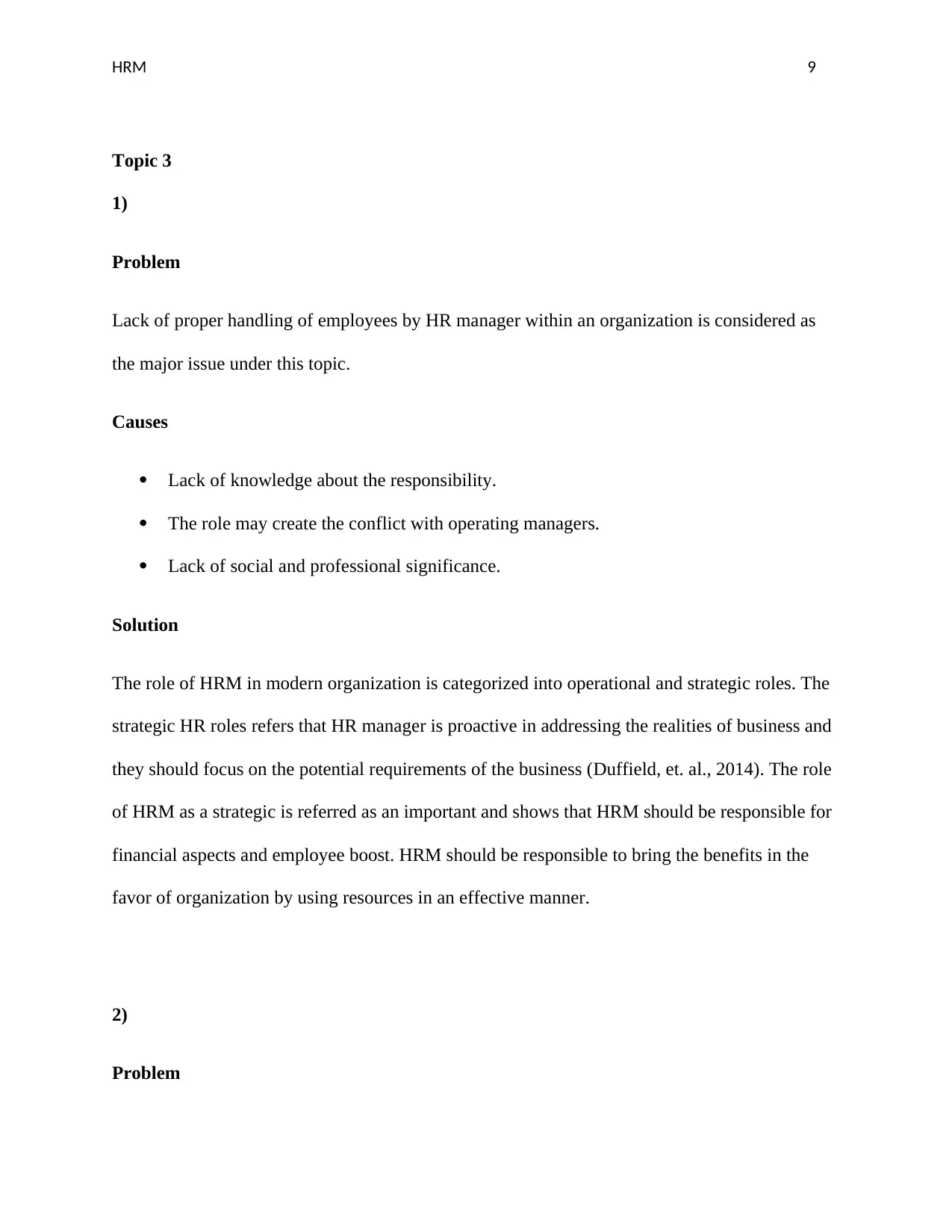
HRM 9
Topic 3
1)
Problem
Lack of proper handling of employees by HR manager within an organization is considered as
the major issue under this topic.
Causes
Lack of knowledge about the responsibility.
The role may create the conflict with operating managers.
Lack of social and professional significance.
Solution
The role of HRM in modern organization is categorized into operational and strategic roles. The
strategic HR roles refers that HR manager is proactive in addressing the realities of business and
they should focus on the potential requirements of the business (Duffield, et. al., 2014). The role
of HRM as a strategic is referred as an important and shows that HRM should be responsible for
financial aspects and employee boost. HRM should be responsible to bring the benefits in the
favor of organization by using resources in an effective manner.
2)
Problem
Topic 3
1)
Problem
Lack of proper handling of employees by HR manager within an organization is considered as
the major issue under this topic.
Causes
Lack of knowledge about the responsibility.
The role may create the conflict with operating managers.
Lack of social and professional significance.
Solution
The role of HRM in modern organization is categorized into operational and strategic roles. The
strategic HR roles refers that HR manager is proactive in addressing the realities of business and
they should focus on the potential requirements of the business (Duffield, et. al., 2014). The role
of HRM as a strategic is referred as an important and shows that HRM should be responsible for
financial aspects and employee boost. HRM should be responsible to bring the benefits in the
favor of organization by using resources in an effective manner.
2)
Problem
⊘ This is a preview!⊘
Do you want full access?
Subscribe today to unlock all pages.

Trusted by 1+ million students worldwide
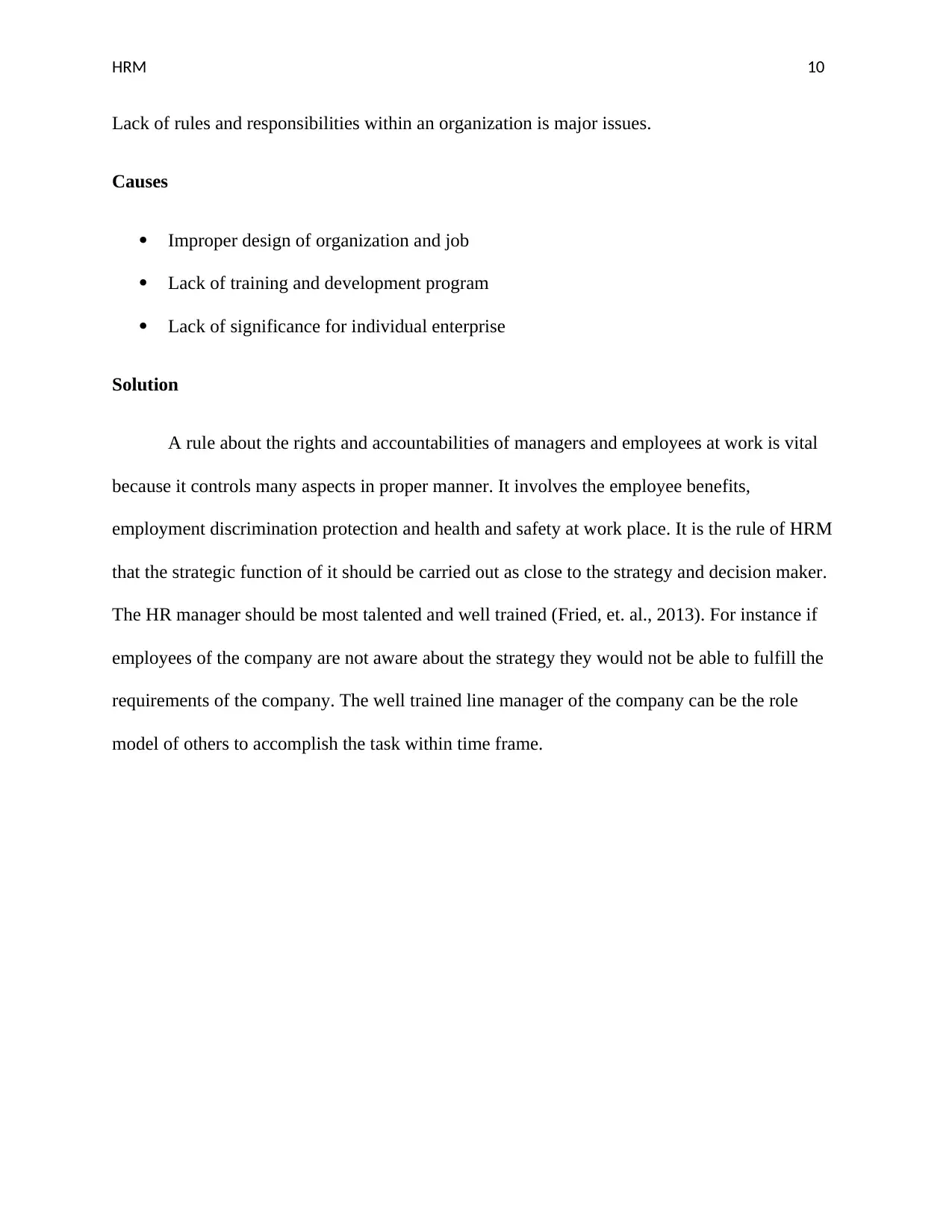
HRM 10
Lack of rules and responsibilities within an organization is major issues.
Causes
Improper design of organization and job
Lack of training and development program
Lack of significance for individual enterprise
Solution
A rule about the rights and accountabilities of managers and employees at work is vital
because it controls many aspects in proper manner. It involves the employee benefits,
employment discrimination protection and health and safety at work place. It is the rule of HRM
that the strategic function of it should be carried out as close to the strategy and decision maker.
The HR manager should be most talented and well trained (Fried, et. al., 2013). For instance if
employees of the company are not aware about the strategy they would not be able to fulfill the
requirements of the company. The well trained line manager of the company can be the role
model of others to accomplish the task within time frame.
Lack of rules and responsibilities within an organization is major issues.
Causes
Improper design of organization and job
Lack of training and development program
Lack of significance for individual enterprise
Solution
A rule about the rights and accountabilities of managers and employees at work is vital
because it controls many aspects in proper manner. It involves the employee benefits,
employment discrimination protection and health and safety at work place. It is the rule of HRM
that the strategic function of it should be carried out as close to the strategy and decision maker.
The HR manager should be most talented and well trained (Fried, et. al., 2013). For instance if
employees of the company are not aware about the strategy they would not be able to fulfill the
requirements of the company. The well trained line manager of the company can be the role
model of others to accomplish the task within time frame.
Paraphrase This Document
Need a fresh take? Get an instant paraphrase of this document with our AI Paraphraser
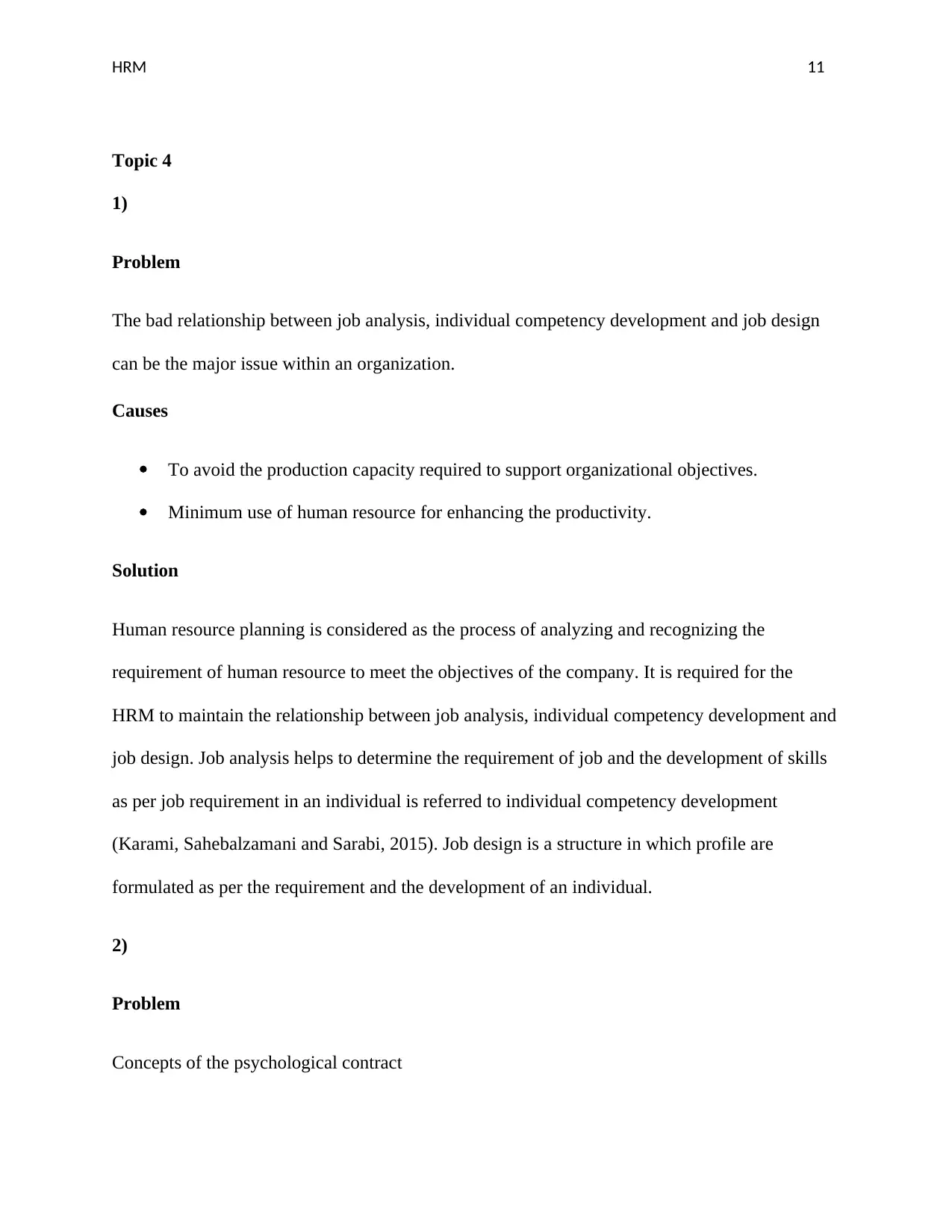
HRM 11
Topic 4
1)
Problem
The bad relationship between job analysis, individual competency development and job design
can be the major issue within an organization.
Causes
To avoid the production capacity required to support organizational objectives.
Minimum use of human resource for enhancing the productivity.
Solution
Human resource planning is considered as the process of analyzing and recognizing the
requirement of human resource to meet the objectives of the company. It is required for the
HRM to maintain the relationship between job analysis, individual competency development and
job design. Job analysis helps to determine the requirement of job and the development of skills
as per job requirement in an individual is referred to individual competency development
(Karami, Sahebalzamani and Sarabi, 2015). Job design is a structure in which profile are
formulated as per the requirement and the development of an individual.
2)
Problem
Concepts of the psychological contract
Topic 4
1)
Problem
The bad relationship between job analysis, individual competency development and job design
can be the major issue within an organization.
Causes
To avoid the production capacity required to support organizational objectives.
Minimum use of human resource for enhancing the productivity.
Solution
Human resource planning is considered as the process of analyzing and recognizing the
requirement of human resource to meet the objectives of the company. It is required for the
HRM to maintain the relationship between job analysis, individual competency development and
job design. Job analysis helps to determine the requirement of job and the development of skills
as per job requirement in an individual is referred to individual competency development
(Karami, Sahebalzamani and Sarabi, 2015). Job design is a structure in which profile are
formulated as per the requirement and the development of an individual.
2)
Problem
Concepts of the psychological contract
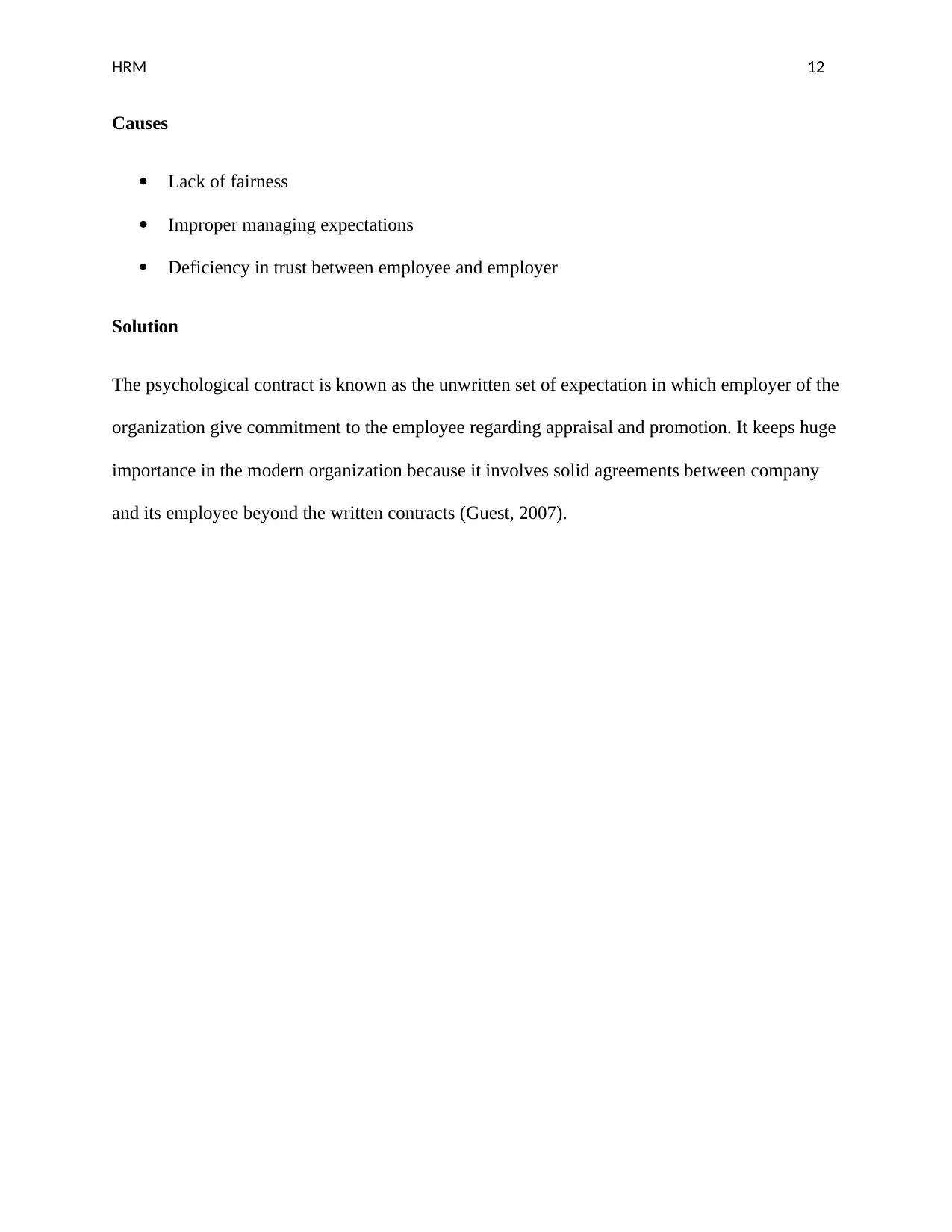
HRM 12
Causes
Lack of fairness
Improper managing expectations
Deficiency in trust between employee and employer
Solution
The psychological contract is known as the unwritten set of expectation in which employer of the
organization give commitment to the employee regarding appraisal and promotion. It keeps huge
importance in the modern organization because it involves solid agreements between company
and its employee beyond the written contracts (Guest, 2007).
Causes
Lack of fairness
Improper managing expectations
Deficiency in trust between employee and employer
Solution
The psychological contract is known as the unwritten set of expectation in which employer of the
organization give commitment to the employee regarding appraisal and promotion. It keeps huge
importance in the modern organization because it involves solid agreements between company
and its employee beyond the written contracts (Guest, 2007).
⊘ This is a preview!⊘
Do you want full access?
Subscribe today to unlock all pages.

Trusted by 1+ million students worldwide
1 out of 27
Related Documents
Your All-in-One AI-Powered Toolkit for Academic Success.
+13062052269
info@desklib.com
Available 24*7 on WhatsApp / Email
![[object Object]](/_next/static/media/star-bottom.7253800d.svg)
Unlock your academic potential
Copyright © 2020–2025 A2Z Services. All Rights Reserved. Developed and managed by ZUCOL.





